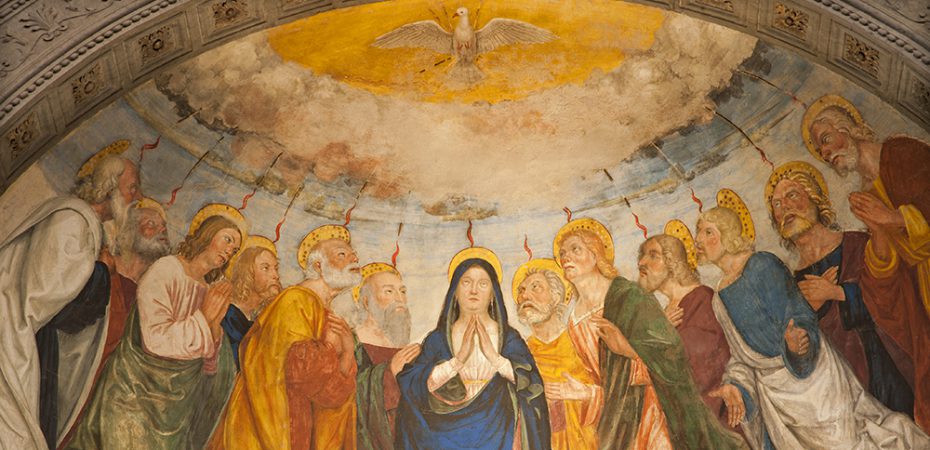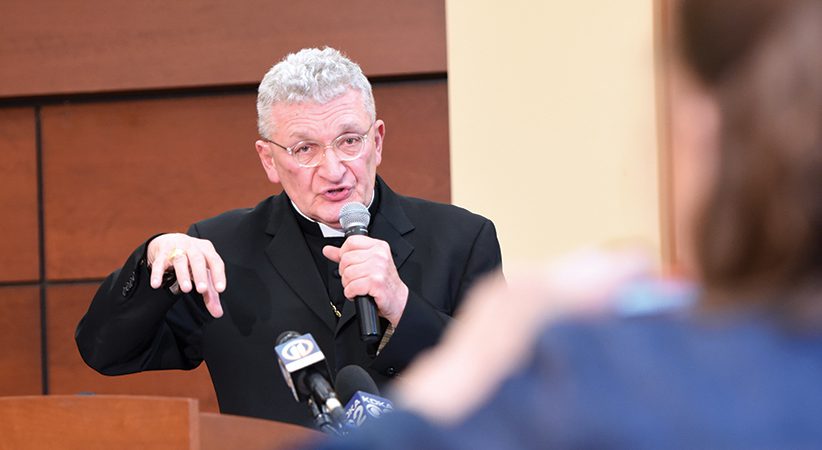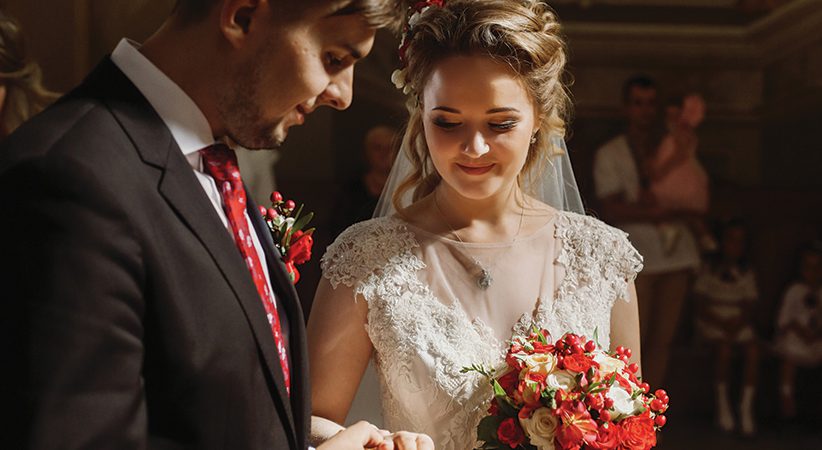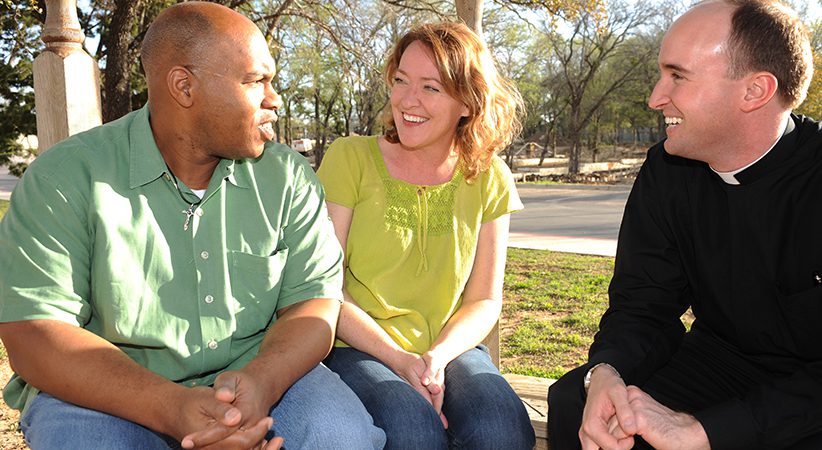Celebrating the Vigil of Pentecost
Exploring the beauty and usefulness of the extended vigil’s readings and orations
Father Paul Turner Comments Off on Celebrating the Vigil of Pentecost
Unabashedly geeky in appearance, the extended form of the Pentecost Vigil slid into the repertoire of uncommon Catholic celebrations with the third edition of the Roman Missal. Adding Scripture readings and orations to the Liturgy of the Word on Pentecost, the extended vigil may appeal more to religious houses and cathedrals than to parishes. Yet, as with much in the liturgy, its usefulness and beauty are grander than they seem.
Vigils in General
Several celebrations in the Catholic calendar are provided with vigil Masses. Christmas, Easter, the Nativity of John the Baptist and the Assumption of the Blessed Virgin Mary all have vigils with presidential prayers and readings that differ from those of the Mass during the day of the particular feast. Anticipated Masses on all Saturdays use the Sunday liturgy.
Even though some parishes call Saturday night Masses “vigils,” they are not so reckoned in the vocabulary of the Roman Missal and its Lectionary. A vigil imagines that people gathering for the evening Mass may come back the next day for another one. A different liturgy on the same theme awaits them.
Vigil Masses challenge homilists, though. Preachers like having the same readings on Saturday evening as on Sunday morning so that they can prepare one parish homily for the weekend. When a vigil presents unique readings, the homiletic plan has to adjust.
All Souls’ Day retains a parallel tradition, though without a vigil. It permits the priest to celebrate three Masses, even on a weekday, and the missal gives him a fresh set of presidential prayers for each. Three distinct sets of readings may be chosen from the Lectionary’s Masses for the dead.
The Easter Vigil is in a class by itself. Unspooling unhurriedly through four contiguous parts, its length is one of its symbols. In theory, people are so joyful in the resurrection of Christ that they don’t want to leave.
Now the Pentecost Vigil offers a similar opportunity. The coming of the Holy Spirit so moves the Church that the gathered community spends extra time together to explore its mystery and rejoice in its promise.
The missal offers two versions of the Pentecost Vigil: The extended form and the simple form. The simple form resembles any other Mass. However, the extended form borrows some elements of the Easter Vigil. These two vigils, then, bookend Easter time.
The missal says that the extended form of the Pentecost Vigil “may be celebrated,” making it optional. It says that the simple form “is used,” meaning that the liturgy on Saturday evening may not take its readings and prayers from the Pentecost Mass during the day. All who come on Saturday observe one of the two forms of the Pentecost Vigil.
They each fulfill the canonical obligation to participate at Mass on Sundays. Some Catholics experiencing the Easter Vigil for the first time bemusedly ask if this fulfills their obligation for Easter. The same question may surface at a Pentecost Vigil. Yes, it fulfills the obligation, and it creates spiritual space for them to return the next day to celebrate Pentecost anew.
The missal offers the option of celebrating Evening Prayer I of Pentecost before, after or in conjunction with this Mass. The extended form of the vigil may therefore expand even further with elements from the Liturgy of the Hours.
In times of pandemic or for other pastoral reasons, the extended form may be imprudent. Otherwise, parishes planning to celebrate the vigil in its splendor would charitably inform those who usually attend the Saturday evening Mass in advance that it will be longer on Pentecost weekend. If people prepare for it, and if it is celebrated well, time will fly.
The Liturgy of the Word gives the extended form of the Pentecost Vigil its unique shape. It shares many similarities with the Liturgy of the Word at the Easter Vigil:
• Before the readings begin, the priest introduces them.
• The Liturgy of the Word increases the number of readings.
• The added readings come from the Old Testament, unlike the rest of Easter time.
• The number of Old Testament readings is proposed, but may be lessened.
• Silence may replace the psalm that follows each Old Testament reading.
• After each psalm or period of silence, all stand while the presider leads them in prayer.
• The singing of the Gloria follows the last of these prayers.
• The epistle follows the Gloria.
These readings, psalms and prayers each contribute to a deeper appreciation of the mystery of Pentecost.
Reading 1
Genesis 11:1-9: The first reading recounts the attempted construction of the Tower of Babel.
The Lord punished the people’s insolence by confusing their speech into diverse languages. The coming of the Holy Spirit at Pentecost rewarded faithful disciples with abilities to communicate in diverse languages. The story of Babel is well known, but its only other appearance in the Lectionary is on Friday of Week Six in Ordinary Time, Year 1. That day falls during a period when the arrival of Lent eliminates part of Ordinary Time. Between 2020 and 2030, that Friday will be observed only twice: 2023 and 2025.
Psalm 33:10-11, 12-13, 14-15: This psalm follows the same reading on that same Friday in Ordinary Time. The verses open ominously, declaring that the Lord frustrates the designs of the nations. Its refrain, however, blesses the people whose God is the Lord.
Prayer after the first reading: The priest prays for the unity of the Church as a holy people. This prayer copies one of the collects from the formula For the Church among the missal’s Masses for Various Needs and Occasions. In light of the first reading, it prays that the unity of the Church may contrast with the splintering of peoples at Babel.
Exodus 19:3-8, 16-20: Moses summoned the people to seal their covenant with the Lord. As Moses ascended the mountain, the people in the camp witnessed thunder and lightning, an immense cloud and the blast of a trumpet. This passage foreshadows the coming of the Holy Spirit amid fire and a noise like a driving wind, giving a new covenant to disciples in the Upper Room.
Reading 2
Daniel 3:52, 53, 54, 55, 56: The Lectionary offers two options for the responsorial. These verses come from the Canticle of the Three Young Men, who praise God for creation from the midst of fire. God looks into the depths from the firmament of heaven. One can envision the most high God visiting the earth in fire.
Psalm 19:8, 9, 10, 11: As an alternative responsorial, these verses of Psalm 19 praise the Lord’s perfect law. The Lectionary pairs them with a refrain based on Jesus’ statement that his words are spirit and life. As God revealed his law to Moses on Mount Sinai and the disciples in the Upper Room, the community sings its praise of the new law in the teaching, life and death of Jesus Christ.
Prayer after the second reading: The priest prays that God, who revealed the ancient law to Moses, will set this gathered community aflame with the Spirit in the new law, the commandment of love. This prayer was newly composed in Latin for the third edition of the Roman Missal in 2008. It is one of the newest prayers in the entire missal and answers the desire of many Catholics for harmony between the readings and the prayers at Mass.
Reading 3
Ezekiel 37:1-14: The prophet sees a valley of dry bones enlivened by the Spirit of God. For Christians, this passage prophesies the life-giving effects of the Holy Spirit on the spiritual life and mission of the Church.
Psalm 107:2-3, 4-5, 6-7, 8-9: Taken from one of the historical psalms, these verses depict a people wandering in a barren desert, but whom the Lord feeds and guides. The Spirit-reconstituted dry bones of the preceding reading help apply this passage to Pentecost.
Prayer after the third reading (1): The missal offers three options. In the first, the priest prays that God, who restores and preserves, will increase the Church through baptism. Like the preceding prayer, this one was newly composed for the missal in 2008.
Prayer after the third reading (2): In the second option the priest prays that God will pour out the Holy Spirit upon the community so that all may attain the resurrection in unity. This one, too, was composed in Latin for the 2008 missal.
Prayer after the third reading (3): In the third option, the priest prays that the people may exult in the youthful spirit of their baptism and look forward to the resurrection. This prayer copies the collect from the Third Sunday of Easter. It was composed for the first edition of the missal after the Second Vatican Council, combining elements from two prayers from the sixth and seventh centuries.
Reading 4
Joel 3:1-5: God promised through the prophet Joel to pour out his spirit upon all flesh, so that the old and the young may dream of the future. Christians believe that this prophecy was fulfilled when the disciples gathered with Mary in the Upper Room on the first Pentecost.
Ps 104:1-2, 24, and 35, 27-28, 29-30: Although the Lectionary presents this psalm frequently, these specific verses are unique to the Pentecost Vigil. The unusual insertion of the psalm’s last line (35c) into the middle of this responsorial probably shows the influence of the Easter Vigil, which offers this psalm as one option after the first reading, and where it concludes with verses 24 and 35c. For the sake of Pentecost, the Lectionary then adds intervening verses: When God sends forth his spirit, he renews the face of the earth.
Prayer after the fourth reading: The priest asks God to fulfill his promise and through the Holy Spirit help the faithful bear witness to the Gospel in the world. This is the alternative collect in the Ritual Mass for the Conferral of Confirmation, and it was composed for the first edition of the missal after the Second Vatican Council.
The Pentecost Vigil Mass
After the Gloria, the priest offers the collect, the first of two options from the simple form. Because each Mass has only one collect, the extended vigil calls the second option a “prayer” and assigns it to the priest before the readings begin.
For the Pentecost Mass during the day, the Lectionary calls for the sequence after the second reading and before the alleluia. As on Easter, there is no sequence at the vigil. However, the Vatican’s annual ordo does permit singing the sequence at the Pentecost Vigil, so the practice has been accepted as an option in the United States.
Priests offering Eucharistic Prayer I (the Roman Canon) replace the Communicantes section with the special one for Pentecost Sunday. It is the last of the options on that page within the Order of Mass.
The deacon or priest who dismisses the assembly adds the double alleluia, and the people respond similarly, “Thanks be to God, alleluia, alleluia.” The dismissal adds this double alleluia only on Easter, the Octave of Easter and Pentecost. It is not sung on the intervening Sundays of Easter Time.
The following day, as Pentecost ends, the Paschal candle is extinguished and moved from its place near the ambo to its regular home near the font. The people who rejoiced in the coming of the Holy Spirit at an extended vigil and perhaps at another Mass the next day return to the Ordinary Time of their life. But it will never be ordinary. Geek or simpleton, they feel in their heart the fire of the Spirit.
FATHER PAUL TURNER is pastor of the Cathedral of the Immaculate Conception and director of the Office of Divine Worship for the Diocese of Kansas City-St. Joseph. Sign up for his blog at www.paulturner.org.
………………………………………………………………………………………………………………………………………………………..
Ties Between the Vigils of Easter and Pentecost
In a May 17, 2017 blog post in Adoremus, Father Dennis Gill connects the significance to the mysteries of the Resurrection and Pentecost. He writes:
“The mysteries of the Resurrection and Pentecost, in ways unique to their respective commemorations, express a sharing of divine life with those who belong to Christ, and especially so for those to be newly incorporated into his body, the Church. Over time these two days saw the development of vigils to watch for the following day’s solemn observance. The proclamation of the Word of God and a response to it would be the chief manner for keeping watch. Also, over time, these vigil days would be marked by fasting and penance in anticipation of the celebrations of the events of the Lord on the solemnity to follow. Likewise, during different periods, these commemorations had octave celebrations associated with them to give liturgical expression to the eternal reality of these same mysteries of Christ. The recently reformed General Roman Calendar sees Pentecost Sunday as the Eighth Sunday of Easter, the conclusion of the eight-week celebration of the Resurrection. So, Pentecost brings to a fitting and final end the celebration of the Resurrection with the promised sending of the Holy Spirit, which in a sense completes the event of Easter.”
…………………………………………………………………………………………………………………………………………………………





